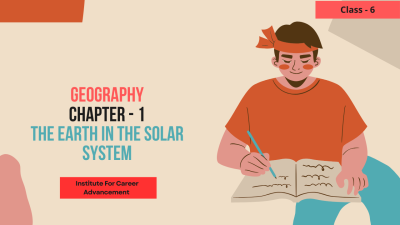The Earth in the Solar System - Class 6
The Earth is the third planet from the Sun and the only planet known to support life. It is a terrestrial planet, meaning it has a solid, rocky surface. Here's a short description of the Earth in the Solar System: Orbit: The Earth orbits the Sun once every 365.25 days, which is one Earth year. Its orbit is nearly circular. Size: The Earth is the largest terrestrial planet in the Solar System. It has a diameter of about 12,742 kilometers (7,918 miles). Atmosphere: The Earth has a thick atmosphere composed primarily of nitrogen and oxygen, with trace amounts of other gases. The atmosphere helps to regulate the Earth's temperature and protects it from harmful solar radiation. Water: The Earth is the only planet in the Solar System known to have liquid water on its surface. Water is essential for life and covers about 71% of the Earth's surface. Moon: The Earth has one large natural satellite, the Moon. The Moon orbits the Earth once every 27.3 days. The Earth is a unique planet in many ways, and it is the only known home to life. Scientists continue to study the Earth to learn more about its history, its current state, and its future. পৃথিবী হল সূর্য থেকে তৃতীয় গ্রহ এবং একমাত্র গ্রহ যা জীবনকে সমর্থন করে। এটি একটি স্থলজ গ্রহ, যার অর্থ এটির একটি শক্ত, পাথুরে পৃষ্ঠ রয়েছে। এখানে সৌরজগতের পৃথিবীর একটি সংক্ষিপ্ত বিবরণ রয়েছেঃ কক্ষপথঃ পৃথিবী প্রতি 365.25 দিনে একবার সূর্যকে প্রদক্ষিণ করে, যা এক পৃথিবীর বছর। এর কক্ষপথ প্রায় বৃত্তাকার। আকারঃ সৌরজগতের বৃহত্তম গ্রহ হল পৃথিবী। এর ব্যাস প্রায় 12,742 কিলোমিটার (7,918 মাইল)। বায়ুমণ্ডলঃ পৃথিবীতে একটি ঘন বায়ুমণ্ডল রয়েছে যা প্রাথমিকভাবে নাইট্রোজেন এবং অক্সিজেন দ্বারা গঠিত, অন্যান্য গ্যাসের অল্প পরিমাণ সহ। বায়ুমণ্ডল পৃথিবীর তাপমাত্রা নিয়ন্ত্রণ করতে এবং ক্ষতিকারক সৌর বিকিরণ থেকে রক্ষা করতে সহায়তা করে। জলঃ পৃথিবী হল সৌরজগতের একমাত্র গ্রহ যার পৃষ্ঠে তরল জল রয়েছে। জল জীবনের জন্য অপরিহার্য এবং পৃথিবীর পৃষ্ঠের প্রায় 71% জুড়ে রয়েছে। চাঁদঃ পৃথিবীর একটি বড় প্রাকৃতিক উপগ্রহ রয়েছে, চাঁদ। চাঁদ প্রতি 27.3 দিনে একবার পৃথিবীকে প্রদক্ষিণ করে। পৃথিবী বিভিন্ন দিক থেকে একটি অনন্য গ্রহ, এবং এটি জীবনের একমাত্র পরিচিত আবাসস্থল। বিজ্ঞানীরা পৃথিবীর ইতিহাস, বর্তমান অবস্থা এবং ভবিষ্যৎ সম্পর্কে আরও জানতে পৃথিবী নিয়ে গবেষণা চালিয়ে যাচ্ছেন।
English
Last updated
Wed, 27-Nov-2024



















